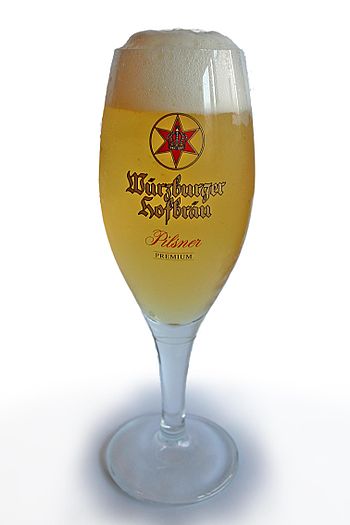Beer is about a lot more than just a great tasting beverage. The fact that a culture has grown up around the joy of making and enjoying fine beer testifies how much beer has become part of how our culture works. The drinking of the beverage is only partially about the taste of the brew itself and very much about where you have your beer, what you drink it out of, how the beer looks in the glass and who you are drinking it with. And while you as a home made beer brewer cannot control many of those factors, you can control the quality and ambiance of the beer you make so it not only tastes great but is visually appealing as well.
 |
| Glas of German "Würzburger Hofbräu" beer, enjoy cold! (Photo credit: Wikipedia) |
If you pour a commercial beer from a bottle or a can, you may not be aware of how much those beer makers put into not just the taste but the affect of other senses have on the beer drinking experience. The way the beer pours, the aroma as you pour it, the head that wells up in your mug and how the beer looks in the glass all are just as important as the taste itself. The emphasis the big beer producers put on ascetics is so extreme that they even make the sound the can makes when you "pop a cold one" to be unique because they know that sound alone can prepare you to receive the taste of a great beer drinking experience.
The truth is none of that will change whether the beer itself is of high quality or is good to drink. But visual appeal matters. One area of visual appeal that you have some control over when making your own beer at home is clarity. Clarity simply refers to how the beer looks in the glass. If you can see through the beer and it is a consistent beige or amber color, that is visually appealing. But if things are floating around in the beer, even if they are perfectly harmless byproducts of the brewing process, that can diminish how inviting your beer is to enjoy and even diminish how enjoyable the beer is to drink even if the beer itself is of high quality.
A lot of the "stuff" that floats around is beer comes from the yeast that is crucial to the fermentation process that makes beer beer. Some yeasts are better than others about settling out of the beer during fermentation. Another source of visible material in the beer comes from what is referred to as non-microbiological particles or NMPs which are a byproduct of the brewing process. Again, none of these visible materials are harmful to consume nor do they reduce the value of the beer. They just look bad and hurt the clarity of the beer which is one way beer is measured for quality.
Many of the NMPs are introduced during the initial creation of the wort which is phase one of any brewing operation. The wort is boiled at a high temperature for a significant enough period of time to cause the proteins in the ingredients to break down and become part of the fluidity of the wort rather than remain in a substance state or a "floc" which remains visible in the finished product. To avoid this make sure your boil sustains a temperature of 215F for 90 minutes to assure complete processing of the proteins.
Another important brewing step that you can do to reduce visible agents in your beer is to cool the wort very quickly. By bringing the temperature down rapidly, the clarity is vastly enhanced as is the flavor and overall quality of the beer. The best way to accomplish such rapid cooling is to move the wort quickly from the brewing process to a very cool environment or using a specialized wort cooler to quickly bring that temperature down and eliminate many of the flocs that might be there if the cooling goes more slowly.
Seeking beer clarity can become a major passion of yours as a home brewer and there is a whole science to using clarifying agents such as Irish Moss to enhance beer clarity without diminishing beer quality or taste. Learning good techniques for making your beer clear and appealing is just another step in your ongoing quest to become the best amateur beer making possible. And that is a quest worth pursuing.

No comments:
Post a Comment